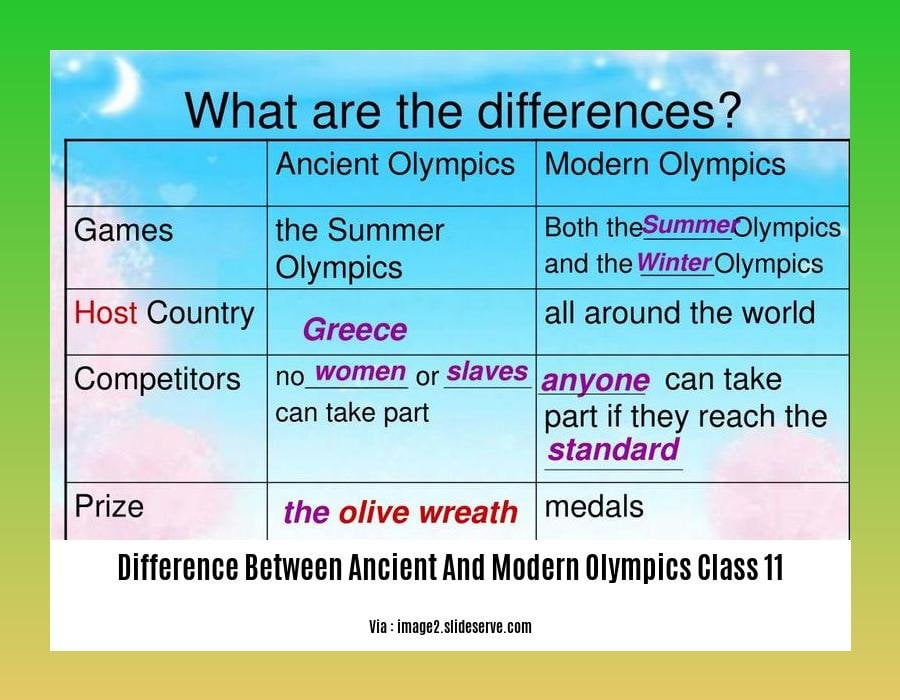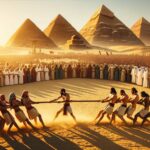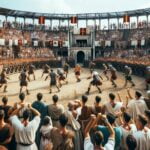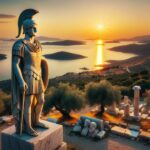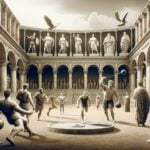Discover the intriguing world of the ancient and current Olympic Games in this thorough book designed for Class 11 students and set off a wonderful trip through time: Knowing the Main Variations between Ancient and Modern Olympics: a Complete Guide for Class 11 Students. From its modest beginnings in ancient Greece to its worldwide splendor today, prepare to discover the fascinating differences and continuities that have molded one of the most famous sporting events in history. This research will help us to appreciate the development of sports, cultural customs, and the Olympic spirit’s legacy going forward.
Important insights:
Variances:
- While ancient Olympics were connected to religion, modern Olympics are secular.
- Modern Games provide 42 disciplines; ancient only six.
- Men and women from many countries participate in modern games; ancient games only featured Greek men.
- Ancient games ran five days; current games run seventeen.
- Ancients bestowed olive wreath upon one winner, while moderns best three finishers received medals.
Likenesses:
- Competitive Spirit: Both stressed agility and quest of perfection.
- International Gathering: Both combined sportsmen from numerous countries.
- Olympic Truce: Both urged a Games-based truce.
- Symbolism: To depict unity and worldwide character of the event, both employed five rings and Olympic flame.
Difference between Ancient and Modern Olympics Class 11
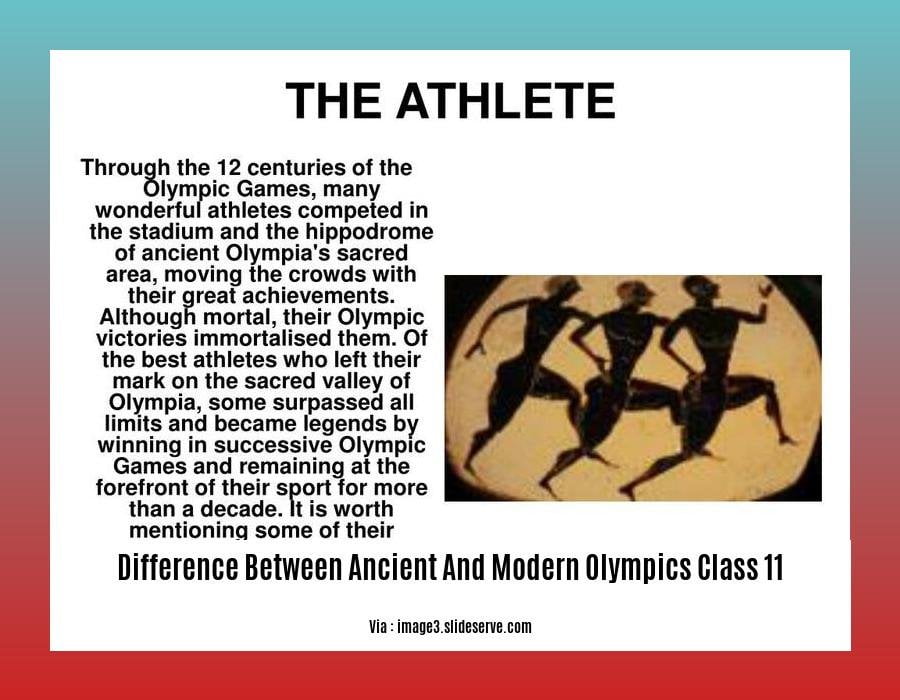
Ever wonder why the ancient Olympics differ from the current Games? Let’s look into their different traits and striking parallels.
Olympic Ancient:
- Deeply ingrained in religious importance and mythology, the ancient Olympics celebrated Greek god Zeus and displayed cultural interaction, artistic ability, and physical power.
- Unlike contemporary Games, the ancient Olympics paid respect to celestial forces, being firmly anchored in religion and mythology.
- Only free Greek men were permitted to participate, representing the social and political backdrop of ancient Greece.
- Ancient Olympics included a small range of disciplines, mostly track and field events, chariot racing, pankration—a mix of wrestling and boxing—and pentathlon—a five-event combo: running, long jump, discus throw, javelin throw, and wrestling.
The Modern Olympics:
- Revived in 1896, the contemporary Olympics reflect the global unity, sportsmanship, and athletic prowess of the day.
- Stripped of religious undertones, modern Games encourage athletic ability and fair competition, strengthening global friendship.
- Reflecting the values of equality and inclusion, athletes from all countries—gender, color, or social background—are invited to compete today.
- Modern Olympics features a great range of sports, including individual and team competitions, summer and winter disciplines, and even showcase sports.
- While the ancient Games ran just five days, the current Olympics extend more than two weeks to allow the great variety of sports and players.
Similarities in Striking:
Though they differ, the ancient and modern Olympics include certain basic ideas:
- Both versions of the Games stress the pursuit of athletic greatness, pushing limits and records in an attitude of fair competition.
- The Olympics gather athletes from all around the world, promoting solidarity and understanding between countries.
- Olympic Truce: Declared both in ancient times and now, a truce during the Games calls for a stop of hostilities, enabling safe passage and athlete participation.
- The Olympic flame and the five rings still represent the worldwide character of the Games, reflecting the unity and variety of the world’s athletes.
Showcasing the ability of athletics to transcend boundaries, civilizations, and time, the ancient and modern Olympics are evidence of mankind’s ongoing passion with sports.
Want to unearth the significant shifts in teaching methodologies over time? Dive into the difference between ancient and modern education to uncover how pedagogical approaches have evolved, shaping the minds of learners across centuries.
Curious about the distinct characteristics that differentiate ancient education systems from their contemporary counterparts? Embark on a journey to explore the difference between ancient and modern education systems, gaining insights into the evolving paradigms of knowledge dissemination and acquisition.
Step into the world of ancient Greek theater and discover the famous ancient greek playwrights who crafted timeless masterpieces. From Aeschylus to Sophocles and Euripides, delve into their profound works and explore the enduring legacy of these literary giants.
Journey through time and trace the tory of ancient israel timeline, uncovering the pivotal events that shaped the nation’s history. From the Exodus to the Babylonian exile and beyond, immerse yourself in the rich tapestry of ancient Israel’s past.
Participation in Ancient Olympics: Limited to Free Male Citizens, Emphasis on Amateurism
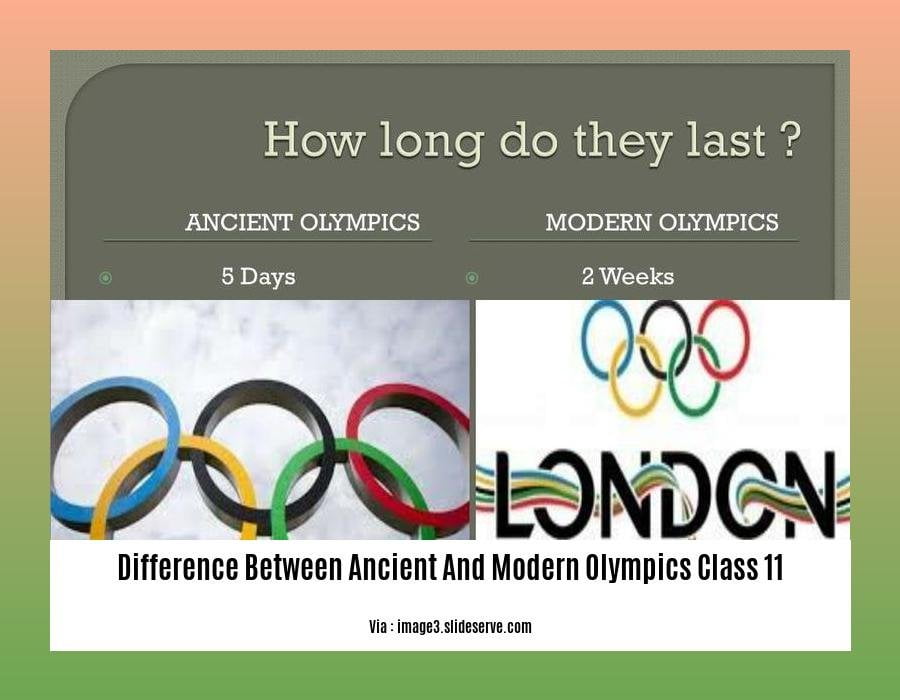
Athletic success was honored in ancient Greece, and rivalry was intense. Possibly the most famous athletic event in history, the Olympics reflected this attitude of agility and friendship. Participating in these ancient games was far from inclusive, though; it was limited to free male citizens, and even within them, there were rigorous rules and limits.
Key Learnings:
- Only free male Greek citizens who had completed intense physical preparation could compete in the ancient Olympics.
- Women were not allowed to take part in the games; non-Greeks, slaves, anybody accused of crimes or blasphemy were excluded as well.
- With contests honoring Zeus, the king of the gods, the ancient Olympics were anchored in religious and cultural traditions.
Restricted Involvement: Free Men Only
Citizenship was a privilege granted only to a small subset of people in ancient Greece: free men born of Greek parentage. This meant that enslaved people were not allowed to compete in the Olympics regardless of their potential or physical aptitudes. Non-Greeks—even those residing in Greek colonies and territory—were also not qualified to compete.
Emphasizing Amateurism: Seeking Personal Glory
In the ancient Olympics, athletes were expected to be amateurs—that is, they participated just for personal glory and renown rather than for financial benefit. Though financial awards were not given, winning an Olympic event conferred great honor and reputation. This focus on amateurism reflected the Greek conviction that sports should be sought for their own purposes—those of self-improvement and physical excellence.
Ancient Olympics: Beyond Conflict
The ancient Olympics were profoundly entwined with Greek religion and culture, not only physical contests. Held every four years at Olympia, a holy site honoring Zeus, the king of the gods, the games drew both viewers and athletes to honor Zeus and engage in religious rites.
Modern Olympics: Legacy and Evolution
Though they vanished in the fourth century CE, the ancient Olympics left a legacy. The late 19th-century Olympic Games resurgence was motivated by athletic standards, fair play, and worldwide unity. Even if the modern Olympics are significantly more inclusive, with athletes from many countries and backgrounds participating in a variety of sports, it is crucial to keep in mind the beginnings of these events and the special conditions that molded its early history.
Participation in Modern Olympics: Open to Athletes from All Nations, Professionalism Accepted
Changing Participation in the Modern Olympic Games
Originally staged in 1896, the modern Olympics broke from the ancient Greek Games in terms of professionalism and inclusivity. These variances mirrored the evolving values and social mores of the day:
Open to Athletes from All Nations: Unlike the ancient Olympics, which limited free Greek male athletes, the modern Games embraced diversity from the first. Athletes from many nations and backgrounds might take part, therefore promoting world harmony and understanding. The modern Olympics nevertheless define themselves in large part by this welcoming attitude.
Professionalism Accepted: Viewed as compromising the values of amateurism and fair competition, professional athletes were severely banned from the ancient Olympics. But the contemporary Olympics came to see how crucial professionalism was to improving athletic performance and increasing the general degree of competitiveness. Professional athletes were authorized to take part in the Games by the early 1900 century. This shift accepted the reality of contemporary sports as well as the rising appeal of professional leagues.
Main conclusions:
- The modern Olympics permit athletes from many countries take part, therefore fostering harmony and understanding amongst many civilizations.
- Professional athletes are let to participate in the modern Games, thereby showing the value of athletic performance and the acceptance of the professional sports sector.
References:
- The Background of the Olympic Events
- Olympic Professionism
Olympic Games Venues: Ancient Olympics Held in Olympia, Greece, Modern Olympics Held Worldwide
How did the ancient Greeks honour their passion for athletics and sports? And how are the current Olympics carrying on this legacy? We will investigate the variances and similarities between the ancient and modern as we untangle the fascinating background of the Olympic Games.
Ancient Olympics: Where All Started
Imagine yourself in the Peloponnese area of Greece, in the sanctuary of Olympia, where the historic Olympic Games began in 776 BC. Held every four years, these quadrennials honored Zeus, the king of gods, and celebrated the height of human ability.
Imagine the excitement of the ancient Greek sprint, in which competitors ran the length of the stadium—equivalent of around 192 meters or 630 feet. With five events—long jump, javelin throw, discus throw, wrestling, and a rigorous 1,500-meter footrace—pentathlon challenged participants’ strength and endurance. Often a violent event, chariot racing was a display of speed and skill with two-horse chariots roaring around the hippodrome, a track especially built for these races.
Contemporary Olympics: An International Show
The return of the Olympic Games in 1896 signaled a fresh turn in sports history. Like its ancient forebeneers, the modern Olympics honors athleticism but has changed in many respects every four years.
Athletes from more than 200 nations come to compete, therefore reflecting a genuinely worldwide sportsmanship. Reflecting the often shifting terrain of athletic competition, today’s Olympics feature a great range of disciplines like gymnastics, swimming, cycling, and archery. With events including electronic timing, video replays, and advanced equipment, the modern Olympics welcomes technology to improve performances and guarantee fair play.
Important Learning Points:
- Olympia Greece: With contests mostly in footraces, wrestling, and chariot racing, the ancient Olympic Games were conducted in Olympia, a holy site devoted to Olympian gods.
- The contemporary Olympics moves among several host cities throughout the globe, and venues are carefully chosen to suit diverse sports as well as the increasing number of participants and spectators.
- With competitors from all around the world competing under one roof, the modern Olympics best reflect world togetherness.
Sources
Ancient Olympic Games
The Modern Olympic Games
q
